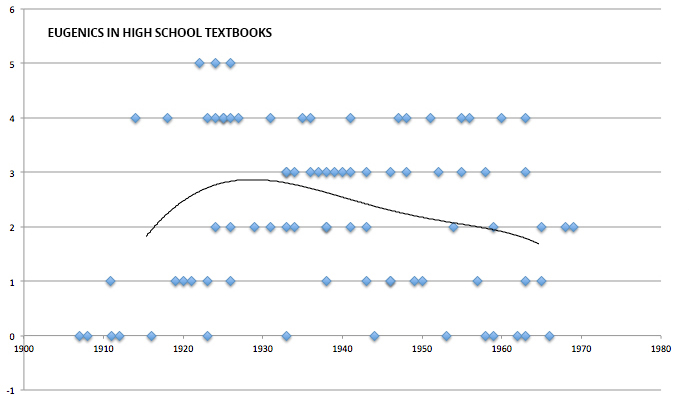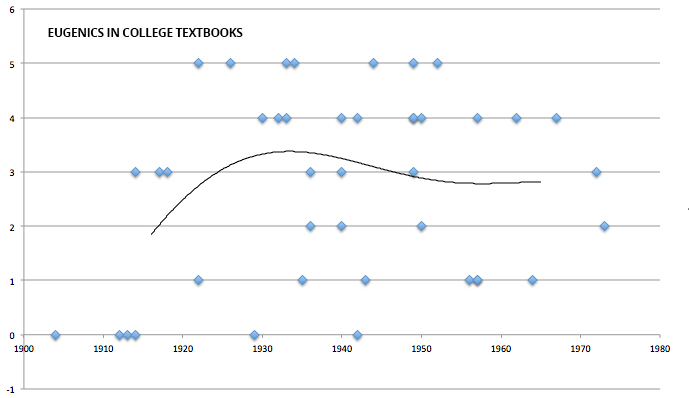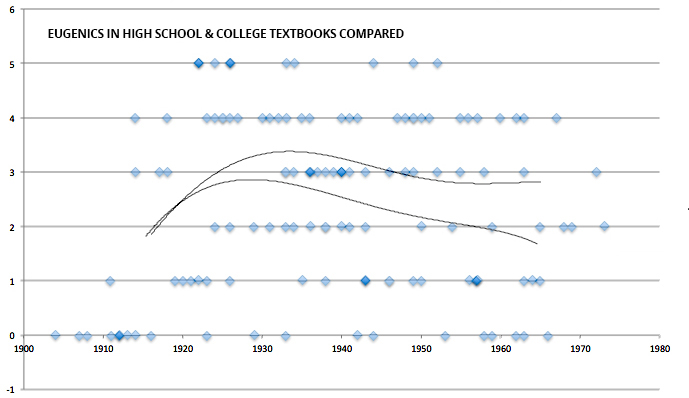June 26, 2014
Eugenics stopped being a topic of credible scientific inquiry in the United States around the time T. H. Morgan’s lab began publishing Drosophila-based genetic data in 1915, or at the latest, when the Carnegie Foundation began to pull funding from the Eugenic Records Office at Cold Spring Harbor in the later 1930s. But its legacy as part of the biology curriculum was much longer-lived than is commonly assumed.
The charts below track the relative priority of the topic of eugenics in the American biology curriculum based on direct examination of 83 high school biology textbooks and 43 college-level biology textbooks published in the United States between 1904 and 1973. (See database).
Tracing the history of the promotion of eugenics in American biology textbooks reveals several surprises.
First, despite the eugenic horror of World War II, the topic of eugenics remained a fixture of a majority of biology textbooks into the 1960s. Second, while the decade between 1925 and 1935 represented the peak of enthusiasm for eugenics in textbooks, this enthusiasm diminished only gradually over the following 30 years. Third, while a few high school textbook authors began to actively counter eugenic claims starting around 1938, college textbook authors continued to present eugenics without disclaimer. Lastly, no college textbook failed to mention eugenics from the mid-1940s on. Forgive the double negative, but what this means is that after World War II, college-level textbooks featured eugenics more routinely than they had in years prior.
The graph above shows that promotion of the topic of eugenics in high school textbooks peaked right around the time of the Scopes trial in 1925, and then gradually declined from about 1929 on. This is in part due to the fact that high school textbook authors and publishers pulled back on their presentation of the topic of evolution, shaving off the burrs that irritated Christian Fundamentalists, in an effort to create textbooks that would have broader appeal in an increasingly nationalized market. As evolution went, so did eugenics. (See Adam Shapiro’s article, Civic Biology and the Origin of the Antievolution Movement, and his book, Trying Biology).
But maybe there is something else going on here?
High school teachers, unlike their college-level colleagues, faced an increasingly diverse student body as the twentieth century wore on. By the 1920s, education through the 10th grade (or more accurately, through age 16) had become compulsory throughout the United States. Girls and boys, rich and poor, old “stock” and recent immigrants all shared the classroom. Eugenics, which is fundamentally premised on variation in inborn qualities, must have been a difficult, if not downright embarrassing lesson to preach.
Race had something to do with it as well – see The Day Eugenics Died.
On the other hand, college classrooms remained decidedly less diverse well into the 1960s. One can assume there was less pressure to issue disclaimers when speaking to a students that likely self-identified as “eugenically fit.” What is striking is how robust the presentation of eugenics remained in college-level textbooks into the 1960s.
The relative robustness of the presentation of the topic of eugenics in college-level textbooks becomes more obvious when we overlay our graphs. While the topic of eugenics began losing favor across the board starting in the 1930s, in college textbooks, eugenics remained as propagandistically promoted into the 1960s as it had been in high school textbooks only at the very peak of the topic’s popularity in the mid-1920s.
Notes on the graphs: A few additional data points have been added since the publication of similar graphs in Eugenics in 20th Century High School Biology Textbooks and Eugenics in 20th Century College Biology Textbooks. The new data altered the college trend line more than than the high school trend line verses those previously published, with a few additional 30’s texts drawing the college curve northward. Additionally, the trend lines relative to the previous graphs have been slightly smoothed, technically now a 5th order rather than a 6th order polynomial regression (said as if I know what that means). Further, the first 11 years and the last 8 years have been deleted from the trend lines to keep the curves from going weird.



